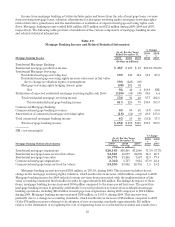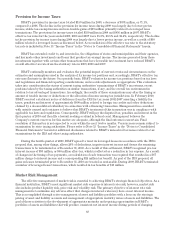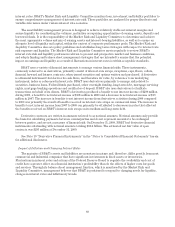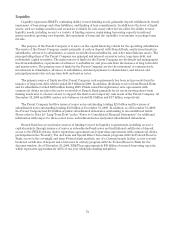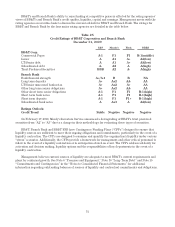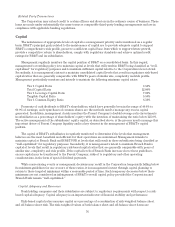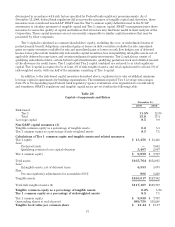BB&T 2009 Annual Report Download - page 71
Download and view the complete annual report
Please find page 71 of the 2009 BB&T annual report below. You can navigate through the pages in the report by either clicking on the pages listed below, or by using the keyword search tool below to find specific information within the annual report.
The asset/liability management process requires a number of key assumptions. Management determines the
most likely outlook for the economy and interest rates by analyzing external factors, including published
economic projections and data, the effects of likely monetary and fiscal policies, as well as any enacted or
prospective regulatory changes. BB&T’s current and prospective liquidity position, current balance sheet
volumes and projected growth, accessibility of funds for short-term needs and capital maintenance are also
considered. This data is combined with various interest rate scenarios to provide management with the
information necessary to analyze interest sensitivity and to aid in the development of strategies to reach
performance goals.
The following table shows the effect that the indicated changes in interest rates would have on net interest
income as projected for the next twelve months under the “most likely” interest rate scenario incorporated into
the Simulation model. Key assumptions in the preparation of the table include prepayment speeds of mortgage-
related assets, cash flows and maturities of derivative financial instruments, loan volumes and pricing, deposit
sensitivity, customer preferences and capital plans. The resulting change in interest sensitive income reflects the
level of sensitivity that interest sensitive income has in relation to changing interest rates.
Table 23
Interest Sensitivity Simulation Analysis
Interest Rate Scenario Annualized Hypothetical
Percentage Change in Net Interest Income
Linear
Change in
Prime Rate
Prime Rate
December 31, December 31,
2009 2008 2009 2008
2.00% 5.25% 5.25% 1.60% 1.87%
1.00 4.25 4.25 .59 1.65
No Change 3.25 3.25 — —
(.25) 3.00 3.00 .38 (1.54)
The Market Risk and Liquidity Committee has established parameters measuring interest sensitivity that
prescribe a maximum negative impact on net interest income of 2% for the next 12 months for a linear change of
100 basis points over four months followed by a flat interest rate scenario for the remaining eight month period,
and a maximum negative impact of 4% for a linear change of 200 basis points over eight months followed by a flat
interest rate scenario for the remaining four month period. In the event that the results of the Simulation model
fall outside the established parameters, management will make recommendations to the Market Risk and
Liquidity Committee on the most appropriate response given the current economic forecast. Management only
modeled a negative 25 basis point decline in the current period because larger declines would have resulted in a
Federal funds rate of less than zero.
The following table shows the effect that the indicated changes in interest rates would have on EVE as
projected under the “most likely” interest rate scenario incorporated into the EVE model. Key assumptions in
the preparation of the table include prepayment speeds of mortgage-related assets, cash flows and maturities of
derivative financial instruments, loan volumes and pricing, and deposit sensitivity. The resulting change in the
economic value of equity reflects the level of sensitivity that EVE has in relation to changing interest rates.
Table 24
Economic Value of Equity ("EVE") Simulation Analysis
Change in
Rates
EVE/Assets Hypothetical Percentage
Change in EVE
December 31, December 31,
2009 2008 2009 2008
2.00% 7.3% 7.2% .6% (2.6)%
1.00 7.3 7.4 .6 1.0
No Change 7.2 7.4 — —
(.25) 7.2 7.3 (.5) (1.3)
71




